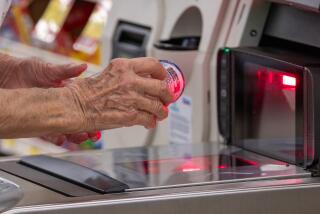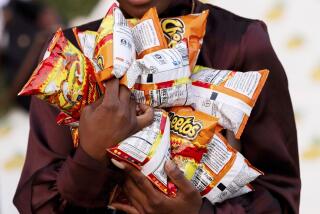Food stamp bills seek to restrict junk food
Reporting from Atlanta — Ronda Storms is a Republican state senator from Florida. She is also a mom who buys the groceries for her family of four.
A few months ago, Storms, 46, started noticing that some fellow shoppers were using federal food stamp money to purchase a lot of unhealthful junk. And it galled her — at a time when Florida was cutting Medicaid reimbursement rates, public school funding and jobs — that people were indulging in sugary, fatty, highly-processed treats on the public dime.
“If we’re going to be cutting services across the board,” she said, “then people can live without potato chips, without store-bought cookies, without their sodas.”
That sense of unfairness, plus a concern about the health of needy children, is the motivation behind a bill Storms sponsored that would prohibit people from purchasing “nonstaple, unhealthy foods” with funds provided by the federal Supplemental Nutrition Assistance Program, or SNAP.
The bill, which was approved 4 to 2 last week by a committee on child and elderly affairs that Storms chairs, is the latest in a flurry of recent statehouse efforts to restrict what shoppers can buy under the federal government’s decades-old food stamp program.
It’s a trend driven by anxiety about health — particularly the national obesity epidemic — but also, in some cases, by a renewed scrutiny of public benefits in a time of tight budgets and staggering want.
According to federal records, more than 46 million Americans are eating groceries bought with SNAP funds. In the last year, legislation seeking to restrict SNAP purchases was introduced in Illinois, Oregon, California, Vermont and Texas, though none was successful, according to the National Conference of State Legislatures.
That is in part because theU.S. Department of Agriculturehas been unwilling to issue further restrictions on food stamp purchases, beyond traditionally ineligible items such as alcohol, tobacco and “hot foods.”
Last year, the USDA rejected New York City MayorMichael R. Bloomberg’s “demonstration project” that would have prohibited soda purchases with food stamps. In 2004, it rejected a Minnesota plan to prohibit the purchase of soft drinks and candy.
In Florida, Storms’ bill is being resisted by anti-hunger advocates, as well as Democrats like Sen. Audrey Gibson of Jacksonville, one of two lawmakers who voted against it Wednesday.
“It’s like we’re attacking poor people because they’re poor, and because they’re asking for some assistance,” Gibson said.
But Storms noted that the other opponents had been the lobbyists for big business: the Corn Refiners of America, the Florida Beverage Assn., the Florida Petroleum Marketers and the Convenience Store Assn.
“Why is that? Because they know they are raking it in from food stamps,” Storms said.
Nationwide, the pushback has come from a rather odd coalition of activist groups and the food industry. In July, a group that included the National Council of La Raza, the Snack Food Assn. and the Frozen Potato Products Institute issued a statement asking the federal government to “preserve food choice” for the poor.
One key objection raised by the coalition — an objection the USDA echoed in its denial of New York’s demonstration project — is the possibility that further restrictions might lead to further stigma. Feeling ashamed or uncomfortable about being on public assistance, advocates believe, may deter people from signing up for food aid. Alleviating such discomfort is one reason SNAP recipients now use electronic benefit cards similar to debit cards, instead of the old paper stamps, which easily identified shoppers on public assistance.
“This business of being treated differently is a big piece of it for us,” said Ellen Vollinger, legal director for the Food Research and Action Center in Washington. “It’s a big step backward, to the age of paper coupons.”
Agriculture Department officials, in a 2007 paper, identified other “serious” problems with the idea of restricting unhealthful foods. Keeping tabs on hundreds of thousands of American food products would be costly and complicated.
Moreover, they argued, there are no “clear standards” for what constitutes healthful food: by some measurements, diet soda, which is low in calories and sugar, could be considered “healthier” than orange juice.
The USDA has also explored the link between SNAP and obesity. A 2008 report found “some evidence” to suggest that food stamp participation increased body mass index, and might contribute to obesity in non-elderly women, though not in children, the elderly and non-elderly men.
Washington is looking for other ways to encourage healthful eating among the poor: In Hampden County, Mass., a federal pilot program is kicking 30 cents on every dollar back to SNAP participants when they buy fruits and vegetables with their benefit cards.
More to Read
Sign up for Essential California
The most important California stories and recommendations in your inbox every morning.
You may occasionally receive promotional content from the Los Angeles Times.










